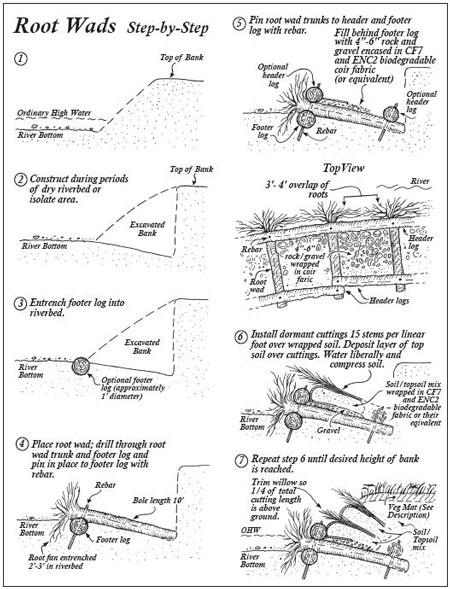Streambank Revegetation and Protection: A Guide for Alaska
Protection Techniques: Root Wads
Root wads are a streambank protection technique that provides immediate riverbank stabilization, protects the toe-of-slope and provides excellent fish habitat, especially for juveniles. They provide toe support for bank revegetation techniques and collect sediment and debris that will enhance bank structure over time. Because of their size, root wads usually require the use of heavy equipment for collection, transport and installation. Consult a streambank revegetation specialist before any streambank revegetation or stabilization technique is utilized in this book.
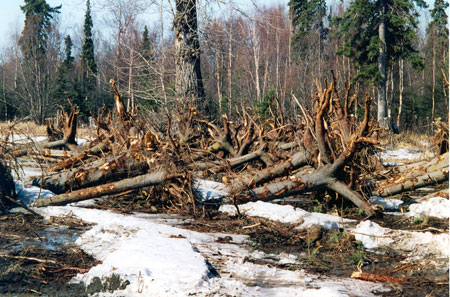
Identify a collection site and obtain permission to remove trees. Collect root wads from forested areas being cleared for development, or selectively remove from treed area. Do not remove trees from riparian zones. Be careful to avoid damage to other trees and vegetation during collection and clearing of rood wads. Larger diameter trees (minimum of 12 inches DBH diameter breast height) can be pushed over when soils are not frozen, leaving root fans intact. The tree tops should be removed, leaving the trunks (boles) a minimum of 10 feet in length with root fans attached. Optimal root fans are a minimum of 5 to 6 feet in diameter.
Construct during times of dry riverbed or isolate work site to prevent sediment erosion into adjacent water bodies. Determine ordinary high water level for proper placement of root wads and subsequent vegetative layers. It is imperative to tie in project to the existing stabilized streambank at the upstream and downstream ends of the project.
Install root wad by excavating into the riverbank deep enough to accommodate an 8 to 10 foot long tree bole (See Root Wads Step-by-Step). Optional header and footer logs may be installed and pinned in place using rebar to help stabilize root wads and the bank. The bole of the root wad is placed into the prepared excavated bank and back-filled with 4-6" rock and gravel encased in two layers of biodegradable fabric. The inner layer of fabric is a fine biodegradable mesh (example: Bon Terra's® ENC2, North American Green's C125 BN, or equivalent) and is placed inside the larger mesh fabric (example: Bon Terra's® CF7, North American Green's CCM-700, or equivalent).
The bole is typically embedded at the level of the riverbed, perpendicular to the river, with the fans parallel to the bank. This placement requires that the riverbed be excavated to partially bury the root fan 2 to 3 feet. Root wads should be installed so that the root fans overlap adjacent root wads to provide continuous coverage along the bank area being treated. The fans should be positioned to undulate with the natural bank, providing additional cover for fish. Additional application methods are described in Applied River Morphology (Rosgen, 1996). Various revegetation techniques may be applied above ordinary high water level after root wad installation to establish native vegetation on the bank. The adjacent Step-by-Step demonstrates brush layering and vegetative mat installations to revegetate the bank above the root wads. To learn more about these methods, please consult the appropriate sections.
Advantages:
- Most stable toe-of-slope protection of techniques mentioned in guide
- Provides fish habitat
- May be used in higher velocity situations
- Helps keep foot traffic off project site
Disadvantages:
- Root wads help limit access to fishery unless grated walkway (gratewalk) and stairs are provided
- Expensive
- Labor intensive
- Heavy equipment required, generally requires contractor
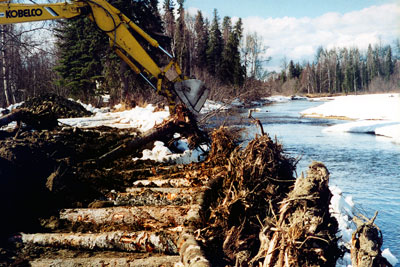
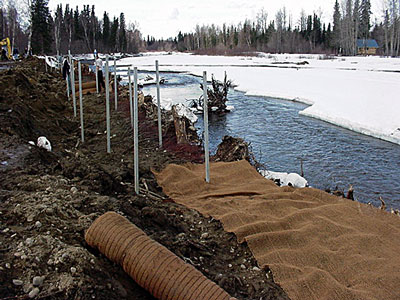
root wads; picture shows the walkway supports installed.
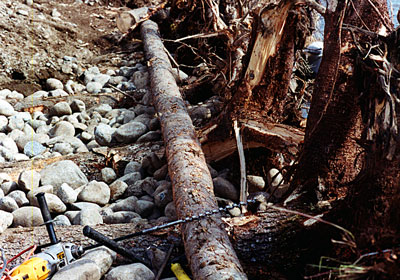
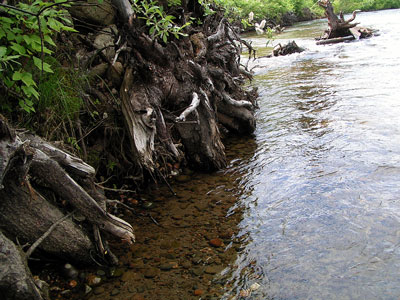
Step-by-Step Guide (PDF 1,076 kB)
